FNSACC503: Budgeting and Forecasting Assignment Solution - Desklib
VerifiedAdded on 2023/06/10
|21
|4437
|317
Homework Assignment
AI Summary
This document provides a comprehensive solution to an assignment focused on FNSACC5ACC503 Manage Budgets and Forecasts. The solution covers various aspects of budgeting, including types of budgets (master, operating, cash flow, sales, production, and financial), the budget cycle (preparation, approval, execution, audit), and the purpose of different budgets such as cash budgets, labor budgets, production budgets, materials budgets, and overhead budgets. It also addresses budget negotiation procedures, the role of milestones in budgeting, steps involved in forecasting, key factors in preparing cash flow estimates, the content of budget spreadsheet reports, different budget formats (static, zero-based, flexible, incremental, rolling), duties in establishing a timeline for budgets, and considerations for monitoring budget outcomes. This assignment solution is designed to provide students with a clear understanding of budgeting and forecasting principles and practices.
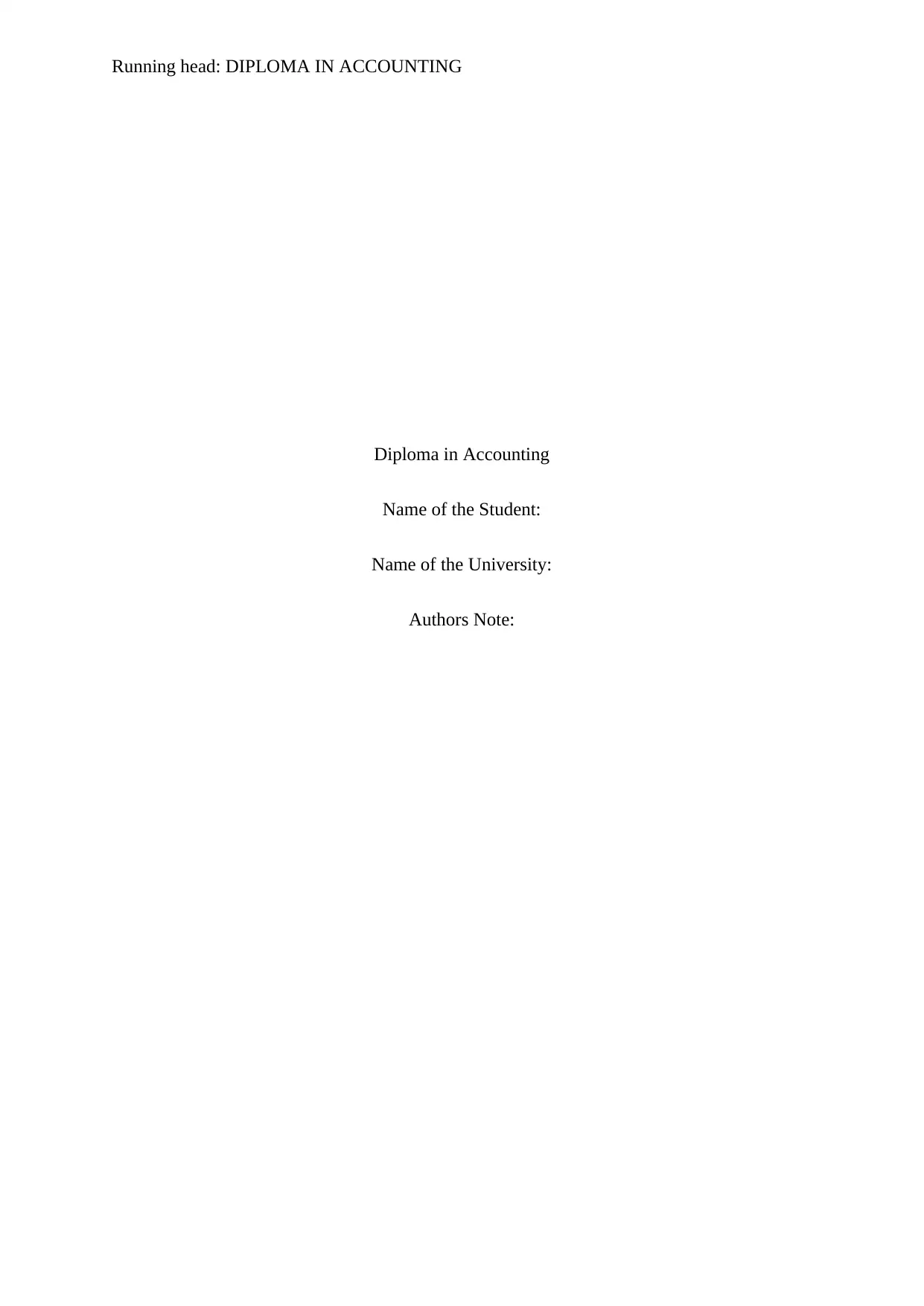
Running head: DIPLOMA IN ACCOUNTING
Diploma in Accounting
Name of the Student:
Name of the University:
Authors Note:
Diploma in Accounting
Name of the Student:
Name of the University:
Authors Note:
Paraphrase This Document
Need a fresh take? Get an instant paraphrase of this document with our AI Paraphraser
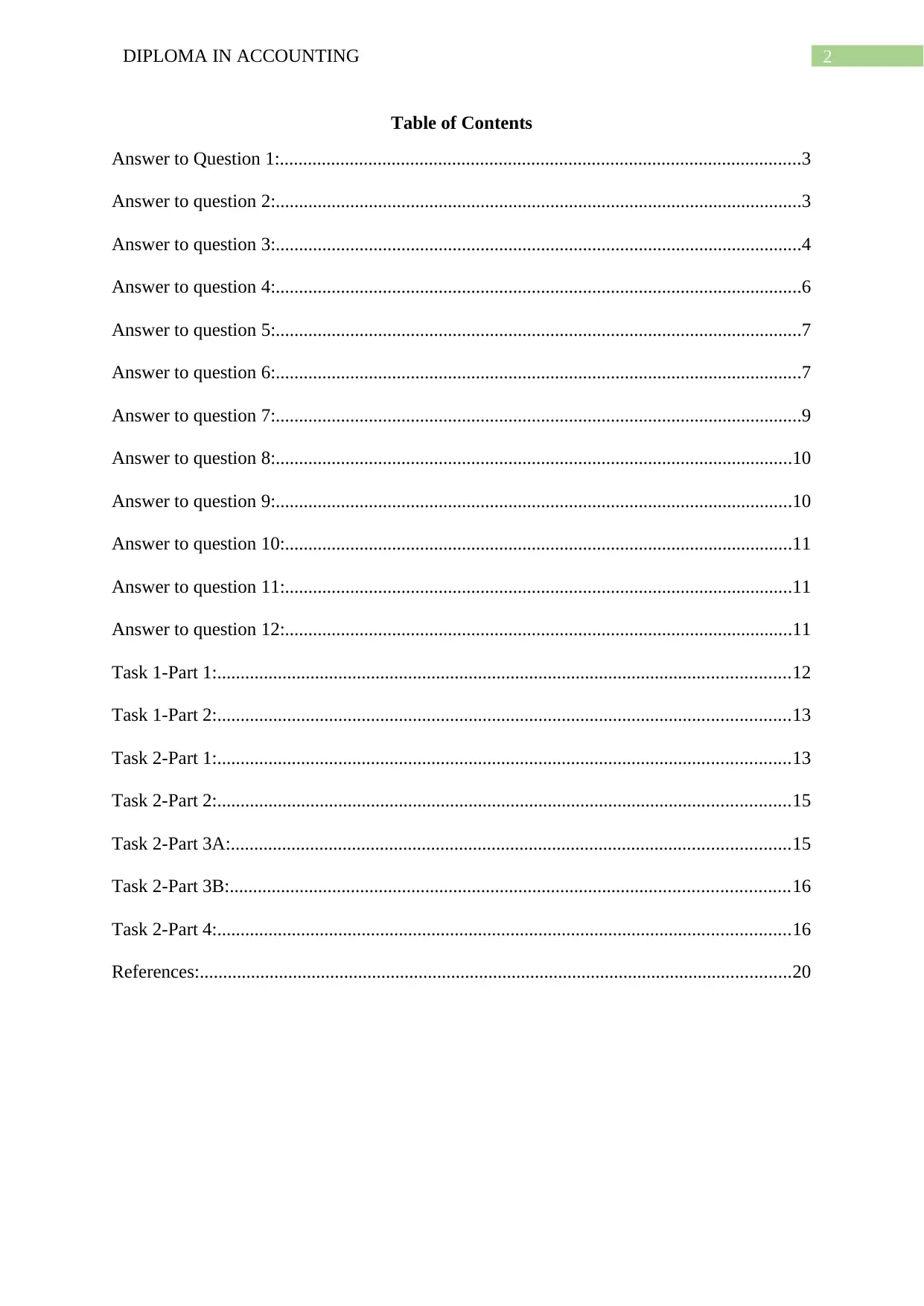
2DIPLOMA IN ACCOUNTING
Table of Contents
Answer to Question 1:................................................................................................................3
Answer to question 2:.................................................................................................................3
Answer to question 3:.................................................................................................................4
Answer to question 4:.................................................................................................................6
Answer to question 5:.................................................................................................................7
Answer to question 6:.................................................................................................................7
Answer to question 7:.................................................................................................................9
Answer to question 8:...............................................................................................................10
Answer to question 9:...............................................................................................................10
Answer to question 10:.............................................................................................................11
Answer to question 11:.............................................................................................................11
Answer to question 12:.............................................................................................................11
Task 1-Part 1:...........................................................................................................................12
Task 1-Part 2:...........................................................................................................................13
Task 2-Part 1:...........................................................................................................................13
Task 2-Part 2:...........................................................................................................................15
Task 2-Part 3A:........................................................................................................................15
Task 2-Part 3B:........................................................................................................................16
Task 2-Part 4:...........................................................................................................................16
References:...............................................................................................................................20
Table of Contents
Answer to Question 1:................................................................................................................3
Answer to question 2:.................................................................................................................3
Answer to question 3:.................................................................................................................4
Answer to question 4:.................................................................................................................6
Answer to question 5:.................................................................................................................7
Answer to question 6:.................................................................................................................7
Answer to question 7:.................................................................................................................9
Answer to question 8:...............................................................................................................10
Answer to question 9:...............................................................................................................10
Answer to question 10:.............................................................................................................11
Answer to question 11:.............................................................................................................11
Answer to question 12:.............................................................................................................11
Task 1-Part 1:...........................................................................................................................12
Task 1-Part 2:...........................................................................................................................13
Task 2-Part 1:...........................................................................................................................13
Task 2-Part 2:...........................................................................................................................15
Task 2-Part 3A:........................................................................................................................15
Task 2-Part 3B:........................................................................................................................16
Task 2-Part 4:...........................................................................................................................16
References:...............................................................................................................................20
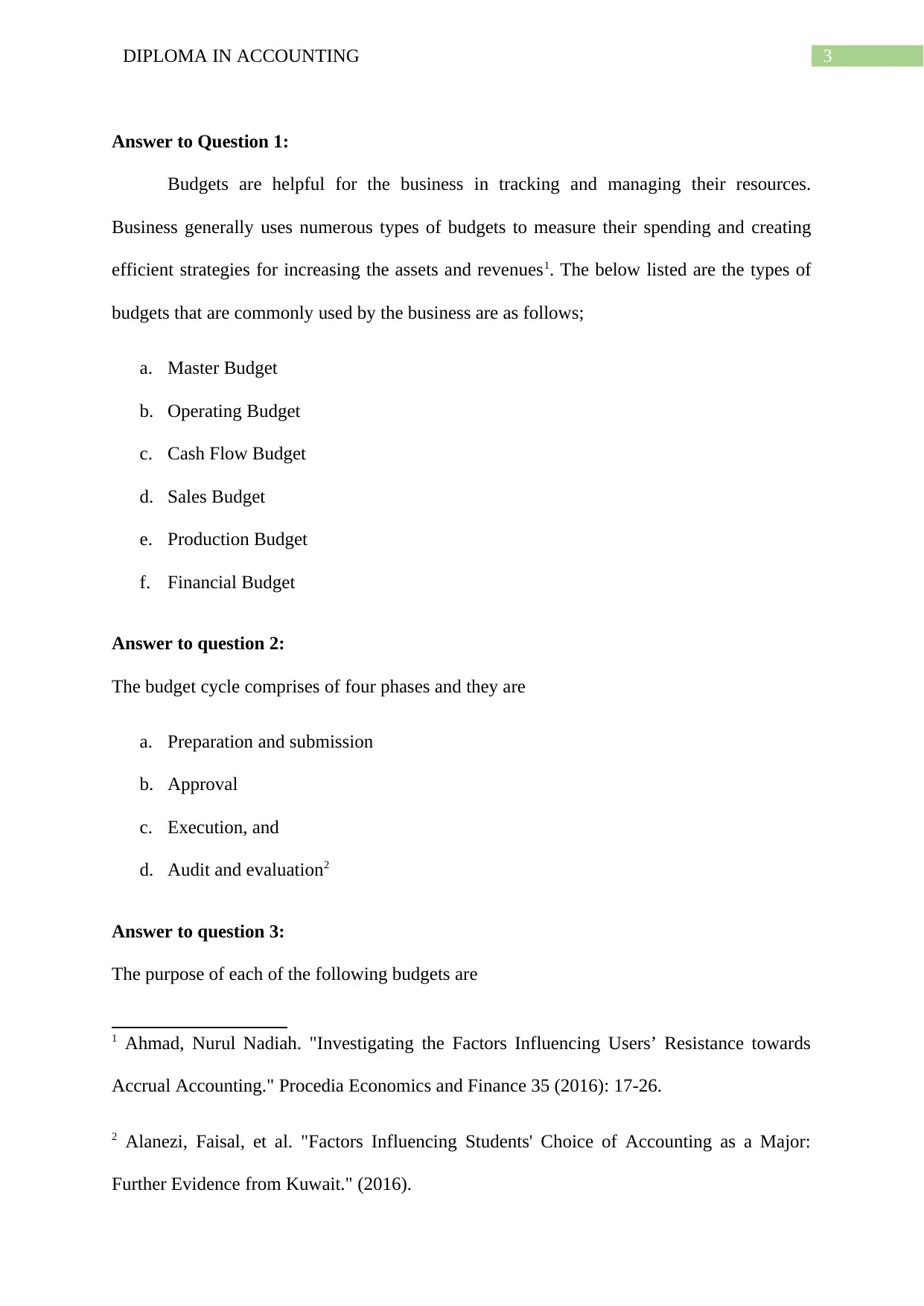
3DIPLOMA IN ACCOUNTING
Answer to Question 1:
Budgets are helpful for the business in tracking and managing their resources.
Business generally uses numerous types of budgets to measure their spending and creating
efficient strategies for increasing the assets and revenues1. The below listed are the types of
budgets that are commonly used by the business are as follows;
a. Master Budget
b. Operating Budget
c. Cash Flow Budget
d. Sales Budget
e. Production Budget
f. Financial Budget
Answer to question 2:
The budget cycle comprises of four phases and they are
a. Preparation and submission
b. Approval
c. Execution, and
d. Audit and evaluation2
Answer to question 3:
The purpose of each of the following budgets are
1 Ahmad, Nurul Nadiah. "Investigating the Factors Influencing Users’ Resistance towards
Accrual Accounting." Procedia Economics and Finance 35 (2016): 17-26.
2 Alanezi, Faisal, et al. "Factors Influencing Students' Choice of Accounting as a Major:
Further Evidence from Kuwait." (2016).
Answer to Question 1:
Budgets are helpful for the business in tracking and managing their resources.
Business generally uses numerous types of budgets to measure their spending and creating
efficient strategies for increasing the assets and revenues1. The below listed are the types of
budgets that are commonly used by the business are as follows;
a. Master Budget
b. Operating Budget
c. Cash Flow Budget
d. Sales Budget
e. Production Budget
f. Financial Budget
Answer to question 2:
The budget cycle comprises of four phases and they are
a. Preparation and submission
b. Approval
c. Execution, and
d. Audit and evaluation2
Answer to question 3:
The purpose of each of the following budgets are
1 Ahmad, Nurul Nadiah. "Investigating the Factors Influencing Users’ Resistance towards
Accrual Accounting." Procedia Economics and Finance 35 (2016): 17-26.
2 Alanezi, Faisal, et al. "Factors Influencing Students' Choice of Accounting as a Major:
Further Evidence from Kuwait." (2016).
⊘ This is a preview!⊘
Do you want full access?
Subscribe today to unlock all pages.

Trusted by 1+ million students worldwide
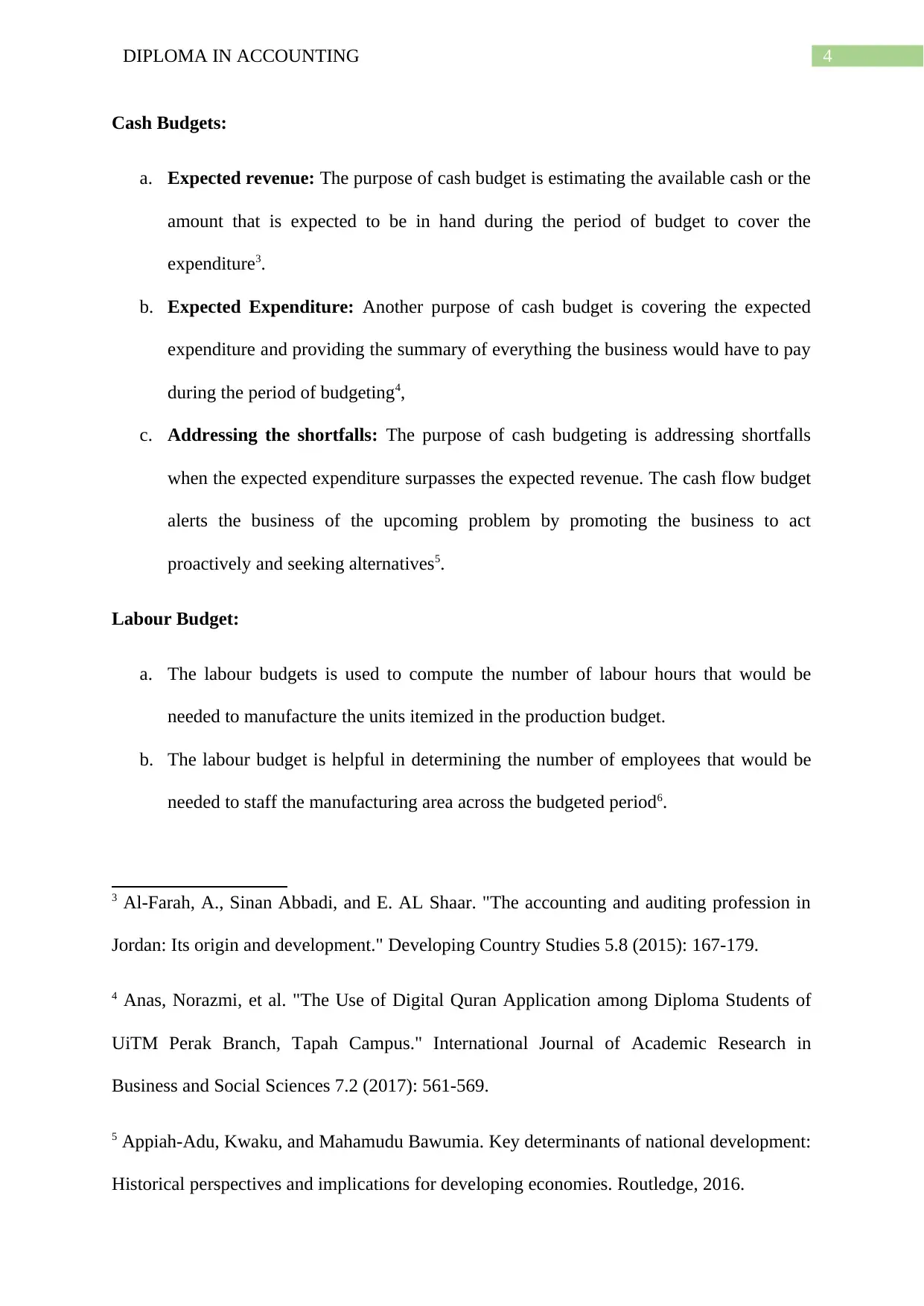
4DIPLOMA IN ACCOUNTING
Cash Budgets:
a. Expected revenue: The purpose of cash budget is estimating the available cash or the
amount that is expected to be in hand during the period of budget to cover the
expenditure3.
b. Expected Expenditure: Another purpose of cash budget is covering the expected
expenditure and providing the summary of everything the business would have to pay
during the period of budgeting4,
c. Addressing the shortfalls: The purpose of cash budgeting is addressing shortfalls
when the expected expenditure surpasses the expected revenue. The cash flow budget
alerts the business of the upcoming problem by promoting the business to act
proactively and seeking alternatives5.
Labour Budget:
a. The labour budgets is used to compute the number of labour hours that would be
needed to manufacture the units itemized in the production budget.
b. The labour budget is helpful in determining the number of employees that would be
needed to staff the manufacturing area across the budgeted period6.
3 Al-Farah, A., Sinan Abbadi, and E. AL Shaar. "The accounting and auditing profession in
Jordan: Its origin and development." Developing Country Studies 5.8 (2015): 167-179.
4 Anas, Norazmi, et al. "The Use of Digital Quran Application among Diploma Students of
UiTM Perak Branch, Tapah Campus." International Journal of Academic Research in
Business and Social Sciences 7.2 (2017): 561-569.
5 Appiah-Adu, Kwaku, and Mahamudu Bawumia. Key determinants of national development:
Historical perspectives and implications for developing economies. Routledge, 2016.
Cash Budgets:
a. Expected revenue: The purpose of cash budget is estimating the available cash or the
amount that is expected to be in hand during the period of budget to cover the
expenditure3.
b. Expected Expenditure: Another purpose of cash budget is covering the expected
expenditure and providing the summary of everything the business would have to pay
during the period of budgeting4,
c. Addressing the shortfalls: The purpose of cash budgeting is addressing shortfalls
when the expected expenditure surpasses the expected revenue. The cash flow budget
alerts the business of the upcoming problem by promoting the business to act
proactively and seeking alternatives5.
Labour Budget:
a. The labour budgets is used to compute the number of labour hours that would be
needed to manufacture the units itemized in the production budget.
b. The labour budget is helpful in determining the number of employees that would be
needed to staff the manufacturing area across the budgeted period6.
3 Al-Farah, A., Sinan Abbadi, and E. AL Shaar. "The accounting and auditing profession in
Jordan: Its origin and development." Developing Country Studies 5.8 (2015): 167-179.
4 Anas, Norazmi, et al. "The Use of Digital Quran Application among Diploma Students of
UiTM Perak Branch, Tapah Campus." International Journal of Academic Research in
Business and Social Sciences 7.2 (2017): 561-569.
5 Appiah-Adu, Kwaku, and Mahamudu Bawumia. Key determinants of national development:
Historical perspectives and implications for developing economies. Routledge, 2016.
Paraphrase This Document
Need a fresh take? Get an instant paraphrase of this document with our AI Paraphraser
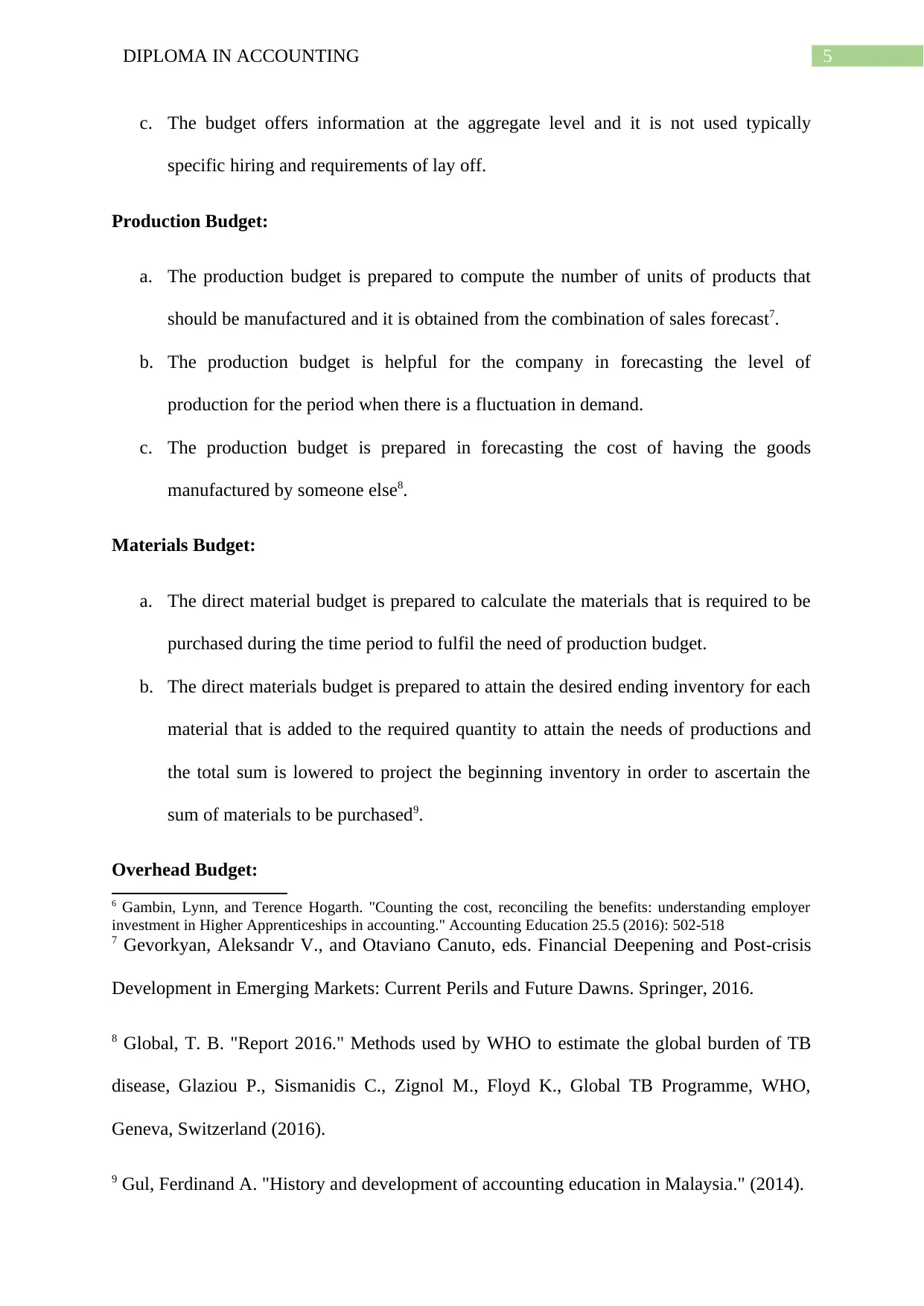
5DIPLOMA IN ACCOUNTING
c. The budget offers information at the aggregate level and it is not used typically
specific hiring and requirements of lay off.
Production Budget:
a. The production budget is prepared to compute the number of units of products that
should be manufactured and it is obtained from the combination of sales forecast7.
b. The production budget is helpful for the company in forecasting the level of
production for the period when there is a fluctuation in demand.
c. The production budget is prepared in forecasting the cost of having the goods
manufactured by someone else8.
Materials Budget:
a. The direct material budget is prepared to calculate the materials that is required to be
purchased during the time period to fulfil the need of production budget.
b. The direct materials budget is prepared to attain the desired ending inventory for each
material that is added to the required quantity to attain the needs of productions and
the total sum is lowered to project the beginning inventory in order to ascertain the
sum of materials to be purchased9.
Overhead Budget:
6 Gambin, Lynn, and Terence Hogarth. "Counting the cost, reconciling the benefits: understanding employer
investment in Higher Apprenticeships in accounting." Accounting Education 25.5 (2016): 502-518
7 Gevorkyan, Aleksandr V., and Otaviano Canuto, eds. Financial Deepening and Post-crisis
Development in Emerging Markets: Current Perils and Future Dawns. Springer, 2016.
8 Global, T. B. "Report 2016." Methods used by WHO to estimate the global burden of TB
disease, Glaziou P., Sismanidis C., Zignol M., Floyd K., Global TB Programme, WHO,
Geneva, Switzerland (2016).
9 Gul, Ferdinand A. "History and development of accounting education in Malaysia." (2014).
c. The budget offers information at the aggregate level and it is not used typically
specific hiring and requirements of lay off.
Production Budget:
a. The production budget is prepared to compute the number of units of products that
should be manufactured and it is obtained from the combination of sales forecast7.
b. The production budget is helpful for the company in forecasting the level of
production for the period when there is a fluctuation in demand.
c. The production budget is prepared in forecasting the cost of having the goods
manufactured by someone else8.
Materials Budget:
a. The direct material budget is prepared to calculate the materials that is required to be
purchased during the time period to fulfil the need of production budget.
b. The direct materials budget is prepared to attain the desired ending inventory for each
material that is added to the required quantity to attain the needs of productions and
the total sum is lowered to project the beginning inventory in order to ascertain the
sum of materials to be purchased9.
Overhead Budget:
6 Gambin, Lynn, and Terence Hogarth. "Counting the cost, reconciling the benefits: understanding employer
investment in Higher Apprenticeships in accounting." Accounting Education 25.5 (2016): 502-518
7 Gevorkyan, Aleksandr V., and Otaviano Canuto, eds. Financial Deepening and Post-crisis
Development in Emerging Markets: Current Perils and Future Dawns. Springer, 2016.
8 Global, T. B. "Report 2016." Methods used by WHO to estimate the global burden of TB
disease, Glaziou P., Sismanidis C., Zignol M., Floyd K., Global TB Programme, WHO,
Geneva, Switzerland (2016).
9 Gul, Ferdinand A. "History and development of accounting education in Malaysia." (2014).
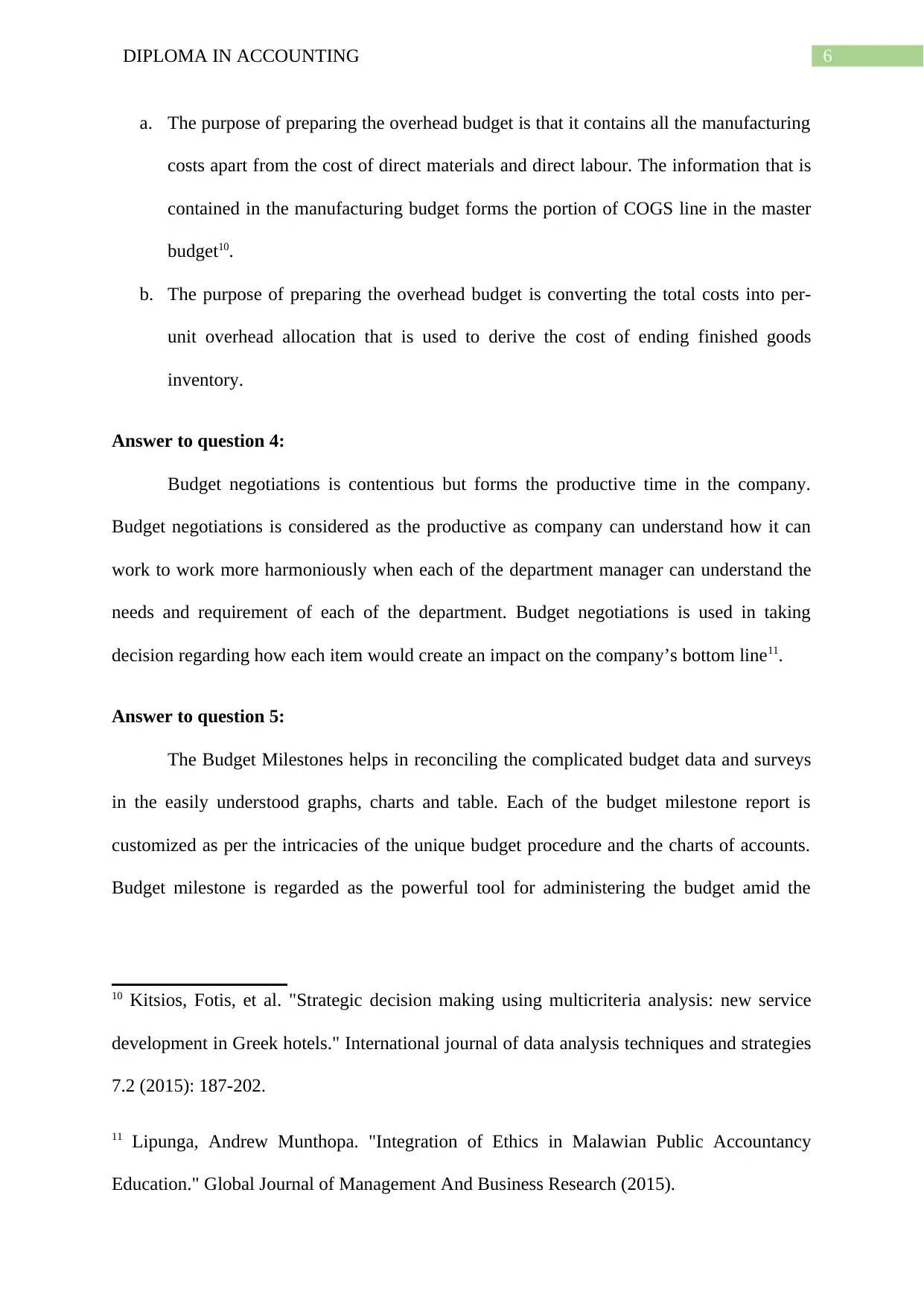
6DIPLOMA IN ACCOUNTING
a. The purpose of preparing the overhead budget is that it contains all the manufacturing
costs apart from the cost of direct materials and direct labour. The information that is
contained in the manufacturing budget forms the portion of COGS line in the master
budget10.
b. The purpose of preparing the overhead budget is converting the total costs into per-
unit overhead allocation that is used to derive the cost of ending finished goods
inventory.
Answer to question 4:
Budget negotiations is contentious but forms the productive time in the company.
Budget negotiations is considered as the productive as company can understand how it can
work to work more harmoniously when each of the department manager can understand the
needs and requirement of each of the department. Budget negotiations is used in taking
decision regarding how each item would create an impact on the company’s bottom line11.
Answer to question 5:
The Budget Milestones helps in reconciling the complicated budget data and surveys
in the easily understood graphs, charts and table. Each of the budget milestone report is
customized as per the intricacies of the unique budget procedure and the charts of accounts.
Budget milestone is regarded as the powerful tool for administering the budget amid the
10 Kitsios, Fotis, et al. "Strategic decision making using multicriteria analysis: new service
development in Greek hotels." International journal of data analysis techniques and strategies
7.2 (2015): 187-202.
11 Lipunga, Andrew Munthopa. "Integration of Ethics in Malawian Public Accountancy
Education." Global Journal of Management And Business Research (2015).
a. The purpose of preparing the overhead budget is that it contains all the manufacturing
costs apart from the cost of direct materials and direct labour. The information that is
contained in the manufacturing budget forms the portion of COGS line in the master
budget10.
b. The purpose of preparing the overhead budget is converting the total costs into per-
unit overhead allocation that is used to derive the cost of ending finished goods
inventory.
Answer to question 4:
Budget negotiations is contentious but forms the productive time in the company.
Budget negotiations is considered as the productive as company can understand how it can
work to work more harmoniously when each of the department manager can understand the
needs and requirement of each of the department. Budget negotiations is used in taking
decision regarding how each item would create an impact on the company’s bottom line11.
Answer to question 5:
The Budget Milestones helps in reconciling the complicated budget data and surveys
in the easily understood graphs, charts and table. Each of the budget milestone report is
customized as per the intricacies of the unique budget procedure and the charts of accounts.
Budget milestone is regarded as the powerful tool for administering the budget amid the
10 Kitsios, Fotis, et al. "Strategic decision making using multicriteria analysis: new service
development in Greek hotels." International journal of data analysis techniques and strategies
7.2 (2015): 187-202.
11 Lipunga, Andrew Munthopa. "Integration of Ethics in Malawian Public Accountancy
Education." Global Journal of Management And Business Research (2015).
⊘ This is a preview!⊘
Do you want full access?
Subscribe today to unlock all pages.

Trusted by 1+ million students worldwide
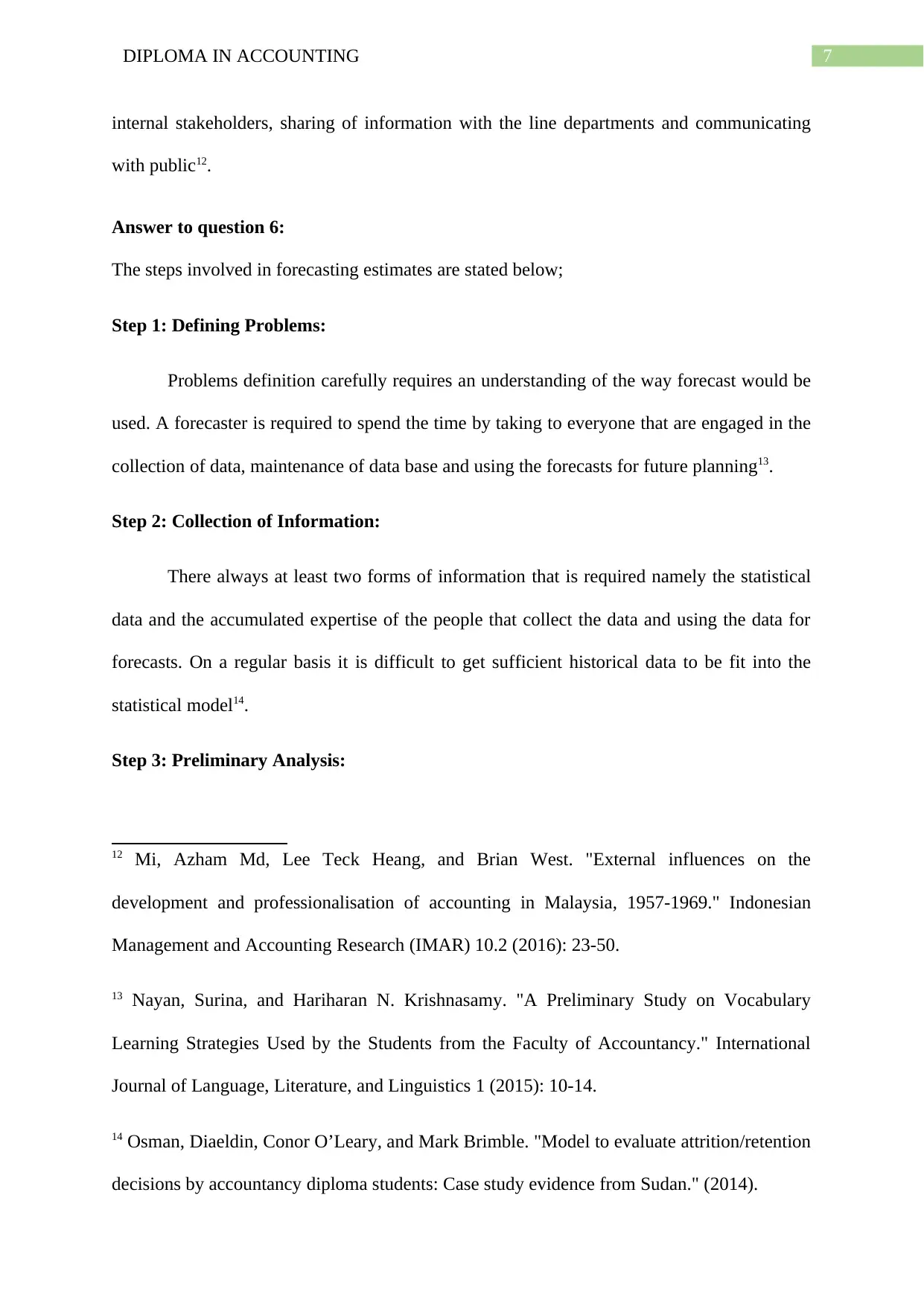
7DIPLOMA IN ACCOUNTING
internal stakeholders, sharing of information with the line departments and communicating
with public12.
Answer to question 6:
The steps involved in forecasting estimates are stated below;
Step 1: Defining Problems:
Problems definition carefully requires an understanding of the way forecast would be
used. A forecaster is required to spend the time by taking to everyone that are engaged in the
collection of data, maintenance of data base and using the forecasts for future planning13.
Step 2: Collection of Information:
There always at least two forms of information that is required namely the statistical
data and the accumulated expertise of the people that collect the data and using the data for
forecasts. On a regular basis it is difficult to get sufficient historical data to be fit into the
statistical model14.
Step 3: Preliminary Analysis:
12 Mi, Azham Md, Lee Teck Heang, and Brian West. "External influences on the
development and professionalisation of accounting in Malaysia, 1957-1969." Indonesian
Management and Accounting Research (IMAR) 10.2 (2016): 23-50.
13 Nayan, Surina, and Hariharan N. Krishnasamy. "A Preliminary Study on Vocabulary
Learning Strategies Used by the Students from the Faculty of Accountancy." International
Journal of Language, Literature, and Linguistics 1 (2015): 10-14.
14 Osman, Diaeldin, Conor O’Leary, and Mark Brimble. "Model to evaluate attrition/retention
decisions by accountancy diploma students: Case study evidence from Sudan." (2014).
internal stakeholders, sharing of information with the line departments and communicating
with public12.
Answer to question 6:
The steps involved in forecasting estimates are stated below;
Step 1: Defining Problems:
Problems definition carefully requires an understanding of the way forecast would be
used. A forecaster is required to spend the time by taking to everyone that are engaged in the
collection of data, maintenance of data base and using the forecasts for future planning13.
Step 2: Collection of Information:
There always at least two forms of information that is required namely the statistical
data and the accumulated expertise of the people that collect the data and using the data for
forecasts. On a regular basis it is difficult to get sufficient historical data to be fit into the
statistical model14.
Step 3: Preliminary Analysis:
12 Mi, Azham Md, Lee Teck Heang, and Brian West. "External influences on the
development and professionalisation of accounting in Malaysia, 1957-1969." Indonesian
Management and Accounting Research (IMAR) 10.2 (2016): 23-50.
13 Nayan, Surina, and Hariharan N. Krishnasamy. "A Preliminary Study on Vocabulary
Learning Strategies Used by the Students from the Faculty of Accountancy." International
Journal of Language, Literature, and Linguistics 1 (2015): 10-14.
14 Osman, Diaeldin, Conor O’Leary, and Mark Brimble. "Model to evaluate attrition/retention
decisions by accountancy diploma students: Case study evidence from Sudan." (2014).
Paraphrase This Document
Need a fresh take? Get an instant paraphrase of this document with our AI Paraphraser
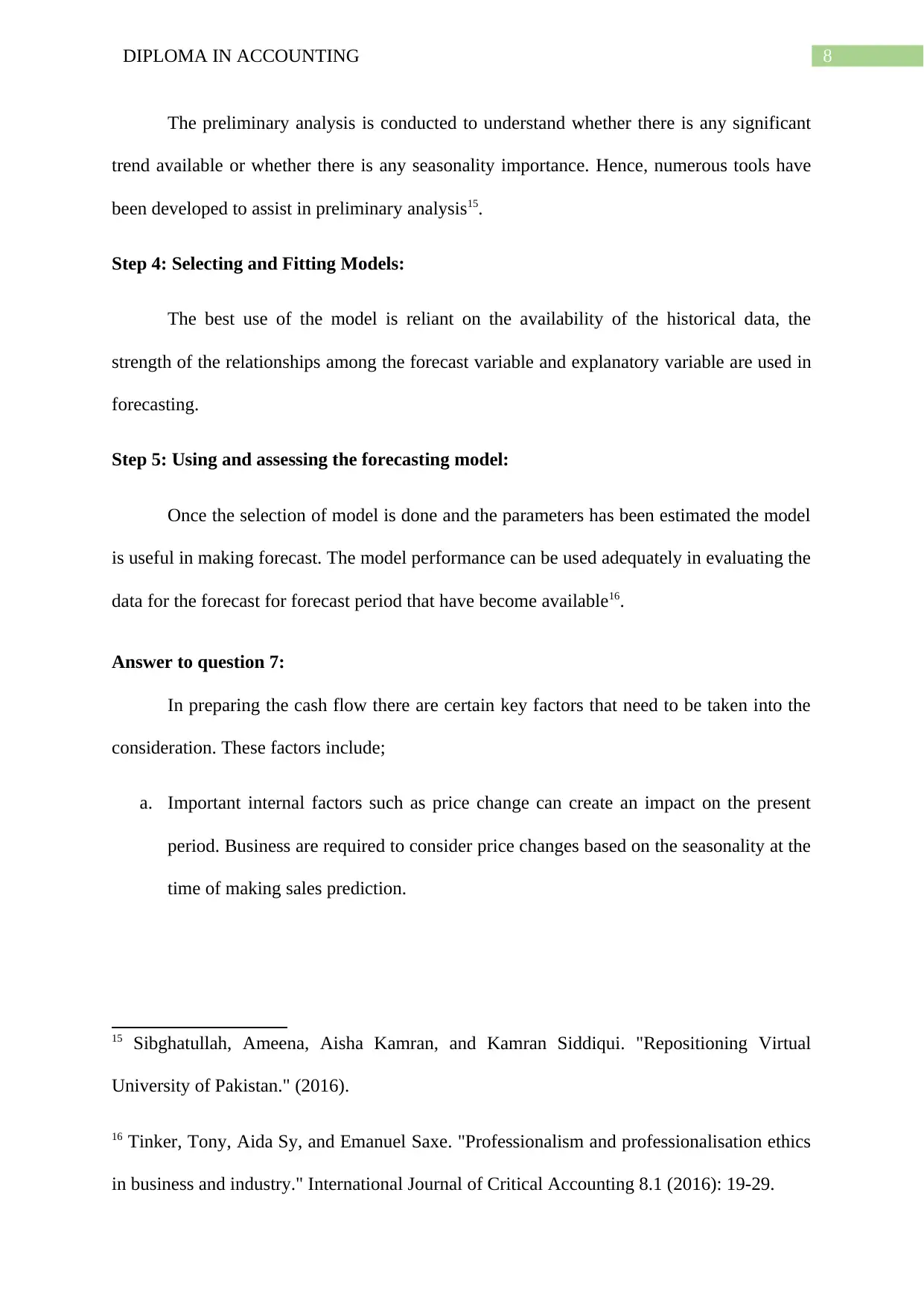
8DIPLOMA IN ACCOUNTING
The preliminary analysis is conducted to understand whether there is any significant
trend available or whether there is any seasonality importance. Hence, numerous tools have
been developed to assist in preliminary analysis15.
Step 4: Selecting and Fitting Models:
The best use of the model is reliant on the availability of the historical data, the
strength of the relationships among the forecast variable and explanatory variable are used in
forecasting.
Step 5: Using and assessing the forecasting model:
Once the selection of model is done and the parameters has been estimated the model
is useful in making forecast. The model performance can be used adequately in evaluating the
data for the forecast for forecast period that have become available16.
Answer to question 7:
In preparing the cash flow there are certain key factors that need to be taken into the
consideration. These factors include;
a. Important internal factors such as price change can create an impact on the present
period. Business are required to consider price changes based on the seasonality at the
time of making sales prediction.
15 Sibghatullah, Ameena, Aisha Kamran, and Kamran Siddiqui. "Repositioning Virtual
University of Pakistan." (2016).
16 Tinker, Tony, Aida Sy, and Emanuel Saxe. "Professionalism and professionalisation ethics
in business and industry." International Journal of Critical Accounting 8.1 (2016): 19-29.
The preliminary analysis is conducted to understand whether there is any significant
trend available or whether there is any seasonality importance. Hence, numerous tools have
been developed to assist in preliminary analysis15.
Step 4: Selecting and Fitting Models:
The best use of the model is reliant on the availability of the historical data, the
strength of the relationships among the forecast variable and explanatory variable are used in
forecasting.
Step 5: Using and assessing the forecasting model:
Once the selection of model is done and the parameters has been estimated the model
is useful in making forecast. The model performance can be used adequately in evaluating the
data for the forecast for forecast period that have become available16.
Answer to question 7:
In preparing the cash flow there are certain key factors that need to be taken into the
consideration. These factors include;
a. Important internal factors such as price change can create an impact on the present
period. Business are required to consider price changes based on the seasonality at the
time of making sales prediction.
15 Sibghatullah, Ameena, Aisha Kamran, and Kamran Siddiqui. "Repositioning Virtual
University of Pakistan." (2016).
16 Tinker, Tony, Aida Sy, and Emanuel Saxe. "Professionalism and professionalisation ethics
in business and industry." International Journal of Critical Accounting 8.1 (2016): 19-29.
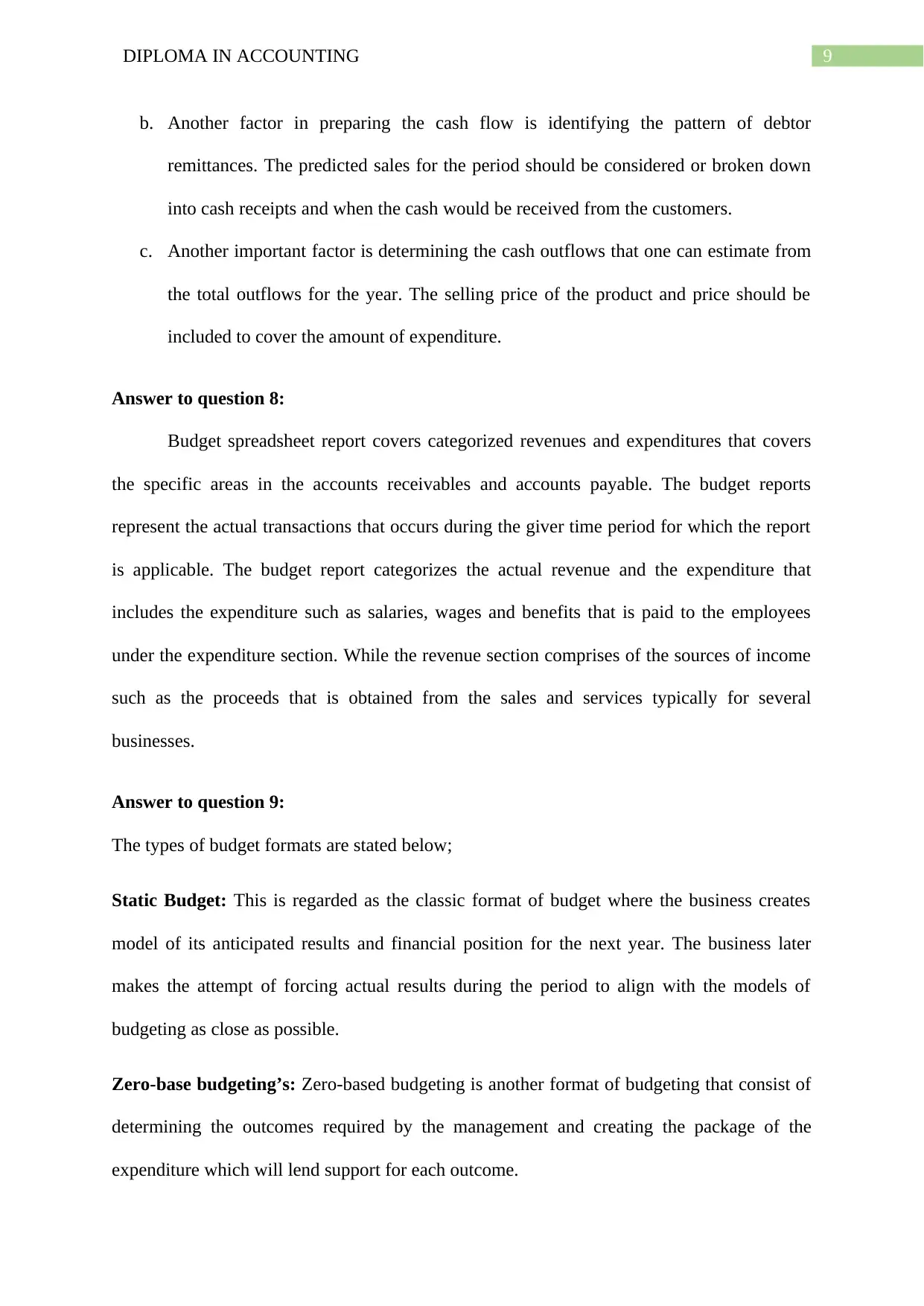
9DIPLOMA IN ACCOUNTING
b. Another factor in preparing the cash flow is identifying the pattern of debtor
remittances. The predicted sales for the period should be considered or broken down
into cash receipts and when the cash would be received from the customers.
c. Another important factor is determining the cash outflows that one can estimate from
the total outflows for the year. The selling price of the product and price should be
included to cover the amount of expenditure.
Answer to question 8:
Budget spreadsheet report covers categorized revenues and expenditures that covers
the specific areas in the accounts receivables and accounts payable. The budget reports
represent the actual transactions that occurs during the giver time period for which the report
is applicable. The budget report categorizes the actual revenue and the expenditure that
includes the expenditure such as salaries, wages and benefits that is paid to the employees
under the expenditure section. While the revenue section comprises of the sources of income
such as the proceeds that is obtained from the sales and services typically for several
businesses.
Answer to question 9:
The types of budget formats are stated below;
Static Budget: This is regarded as the classic format of budget where the business creates
model of its anticipated results and financial position for the next year. The business later
makes the attempt of forcing actual results during the period to align with the models of
budgeting as close as possible.
Zero-base budgeting’s: Zero-based budgeting is another format of budgeting that consist of
determining the outcomes required by the management and creating the package of the
expenditure which will lend support for each outcome.
b. Another factor in preparing the cash flow is identifying the pattern of debtor
remittances. The predicted sales for the period should be considered or broken down
into cash receipts and when the cash would be received from the customers.
c. Another important factor is determining the cash outflows that one can estimate from
the total outflows for the year. The selling price of the product and price should be
included to cover the amount of expenditure.
Answer to question 8:
Budget spreadsheet report covers categorized revenues and expenditures that covers
the specific areas in the accounts receivables and accounts payable. The budget reports
represent the actual transactions that occurs during the giver time period for which the report
is applicable. The budget report categorizes the actual revenue and the expenditure that
includes the expenditure such as salaries, wages and benefits that is paid to the employees
under the expenditure section. While the revenue section comprises of the sources of income
such as the proceeds that is obtained from the sales and services typically for several
businesses.
Answer to question 9:
The types of budget formats are stated below;
Static Budget: This is regarded as the classic format of budget where the business creates
model of its anticipated results and financial position for the next year. The business later
makes the attempt of forcing actual results during the period to align with the models of
budgeting as close as possible.
Zero-base budgeting’s: Zero-based budgeting is another format of budgeting that consist of
determining the outcomes required by the management and creating the package of the
expenditure which will lend support for each outcome.
⊘ This is a preview!⊘
Do you want full access?
Subscribe today to unlock all pages.

Trusted by 1+ million students worldwide
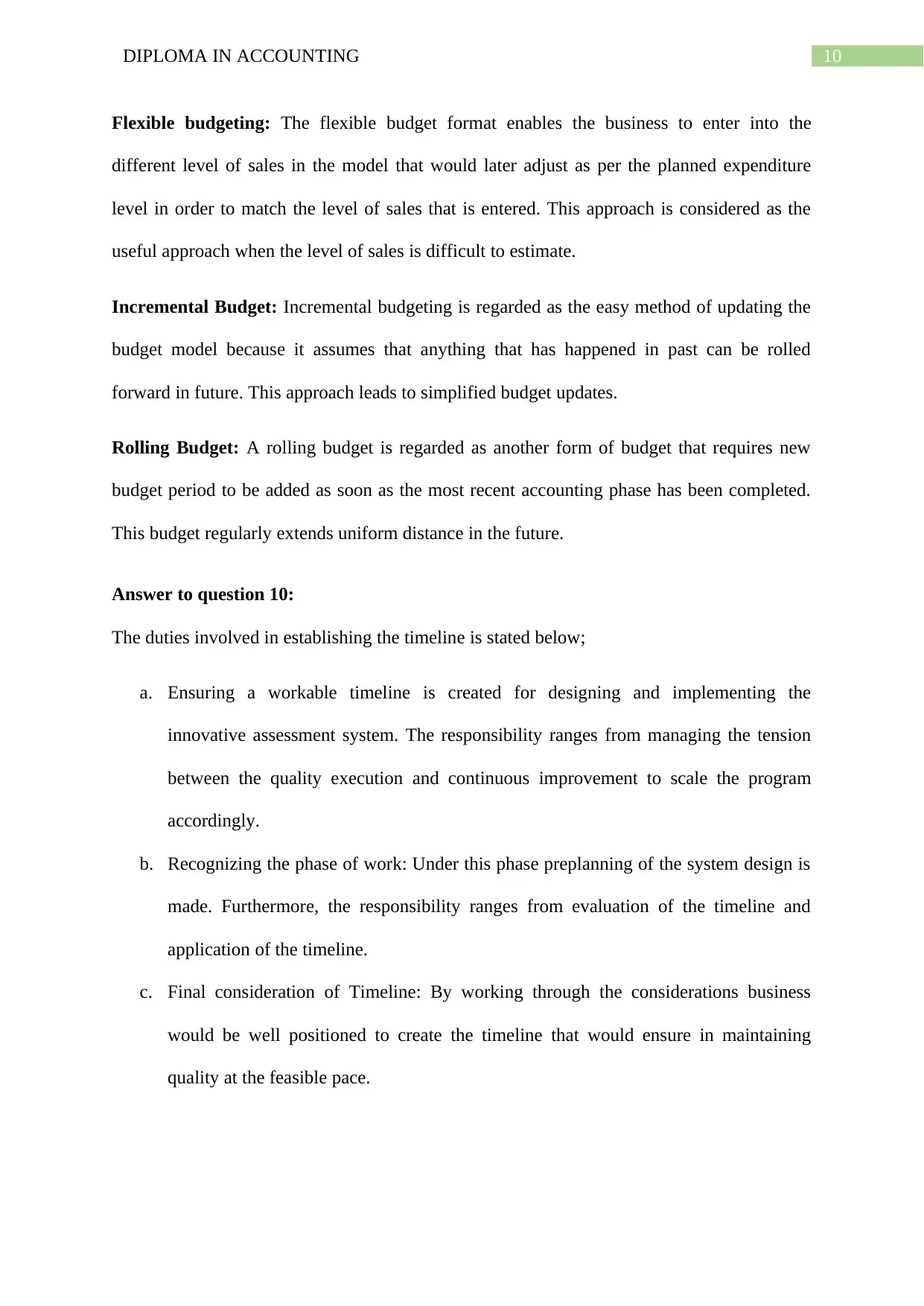
10DIPLOMA IN ACCOUNTING
Flexible budgeting: The flexible budget format enables the business to enter into the
different level of sales in the model that would later adjust as per the planned expenditure
level in order to match the level of sales that is entered. This approach is considered as the
useful approach when the level of sales is difficult to estimate.
Incremental Budget: Incremental budgeting is regarded as the easy method of updating the
budget model because it assumes that anything that has happened in past can be rolled
forward in future. This approach leads to simplified budget updates.
Rolling Budget: A rolling budget is regarded as another form of budget that requires new
budget period to be added as soon as the most recent accounting phase has been completed.
This budget regularly extends uniform distance in the future.
Answer to question 10:
The duties involved in establishing the timeline is stated below;
a. Ensuring a workable timeline is created for designing and implementing the
innovative assessment system. The responsibility ranges from managing the tension
between the quality execution and continuous improvement to scale the program
accordingly.
b. Recognizing the phase of work: Under this phase preplanning of the system design is
made. Furthermore, the responsibility ranges from evaluation of the timeline and
application of the timeline.
c. Final consideration of Timeline: By working through the considerations business
would be well positioned to create the timeline that would ensure in maintaining
quality at the feasible pace.
Flexible budgeting: The flexible budget format enables the business to enter into the
different level of sales in the model that would later adjust as per the planned expenditure
level in order to match the level of sales that is entered. This approach is considered as the
useful approach when the level of sales is difficult to estimate.
Incremental Budget: Incremental budgeting is regarded as the easy method of updating the
budget model because it assumes that anything that has happened in past can be rolled
forward in future. This approach leads to simplified budget updates.
Rolling Budget: A rolling budget is regarded as another form of budget that requires new
budget period to be added as soon as the most recent accounting phase has been completed.
This budget regularly extends uniform distance in the future.
Answer to question 10:
The duties involved in establishing the timeline is stated below;
a. Ensuring a workable timeline is created for designing and implementing the
innovative assessment system. The responsibility ranges from managing the tension
between the quality execution and continuous improvement to scale the program
accordingly.
b. Recognizing the phase of work: Under this phase preplanning of the system design is
made. Furthermore, the responsibility ranges from evaluation of the timeline and
application of the timeline.
c. Final consideration of Timeline: By working through the considerations business
would be well positioned to create the timeline that would ensure in maintaining
quality at the feasible pace.
Paraphrase This Document
Need a fresh take? Get an instant paraphrase of this document with our AI Paraphraser
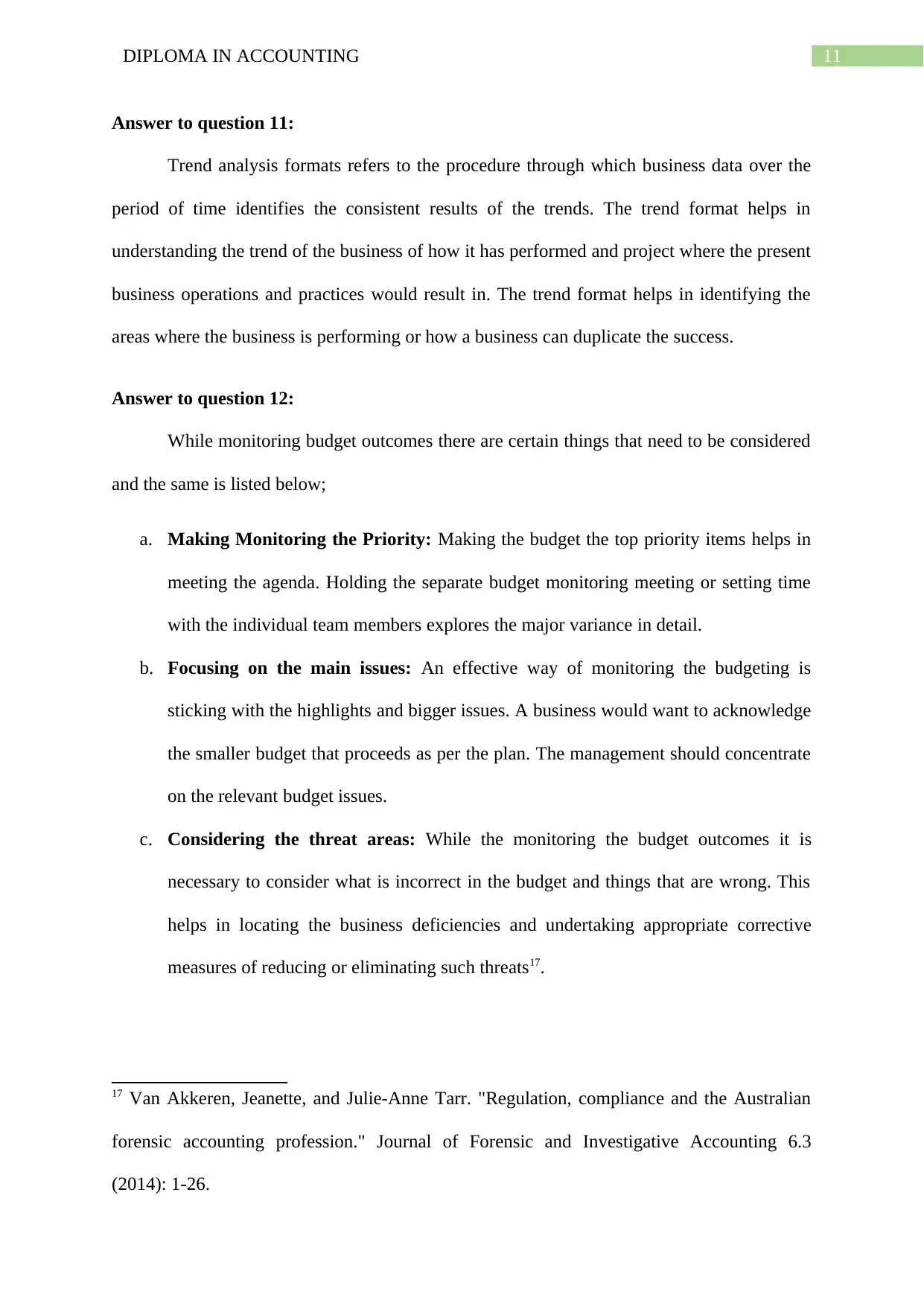
11DIPLOMA IN ACCOUNTING
Answer to question 11:
Trend analysis formats refers to the procedure through which business data over the
period of time identifies the consistent results of the trends. The trend format helps in
understanding the trend of the business of how it has performed and project where the present
business operations and practices would result in. The trend format helps in identifying the
areas where the business is performing or how a business can duplicate the success.
Answer to question 12:
While monitoring budget outcomes there are certain things that need to be considered
and the same is listed below;
a. Making Monitoring the Priority: Making the budget the top priority items helps in
meeting the agenda. Holding the separate budget monitoring meeting or setting time
with the individual team members explores the major variance in detail.
b. Focusing on the main issues: An effective way of monitoring the budgeting is
sticking with the highlights and bigger issues. A business would want to acknowledge
the smaller budget that proceeds as per the plan. The management should concentrate
on the relevant budget issues.
c. Considering the threat areas: While the monitoring the budget outcomes it is
necessary to consider what is incorrect in the budget and things that are wrong. This
helps in locating the business deficiencies and undertaking appropriate corrective
measures of reducing or eliminating such threats17.
17 Van Akkeren, Jeanette, and Julie-Anne Tarr. "Regulation, compliance and the Australian
forensic accounting profession." Journal of Forensic and Investigative Accounting 6.3
(2014): 1-26.
Answer to question 11:
Trend analysis formats refers to the procedure through which business data over the
period of time identifies the consistent results of the trends. The trend format helps in
understanding the trend of the business of how it has performed and project where the present
business operations and practices would result in. The trend format helps in identifying the
areas where the business is performing or how a business can duplicate the success.
Answer to question 12:
While monitoring budget outcomes there are certain things that need to be considered
and the same is listed below;
a. Making Monitoring the Priority: Making the budget the top priority items helps in
meeting the agenda. Holding the separate budget monitoring meeting or setting time
with the individual team members explores the major variance in detail.
b. Focusing on the main issues: An effective way of monitoring the budgeting is
sticking with the highlights and bigger issues. A business would want to acknowledge
the smaller budget that proceeds as per the plan. The management should concentrate
on the relevant budget issues.
c. Considering the threat areas: While the monitoring the budget outcomes it is
necessary to consider what is incorrect in the budget and things that are wrong. This
helps in locating the business deficiencies and undertaking appropriate corrective
measures of reducing or eliminating such threats17.
17 Van Akkeren, Jeanette, and Julie-Anne Tarr. "Regulation, compliance and the Australian
forensic accounting profession." Journal of Forensic and Investigative Accounting 6.3
(2014): 1-26.
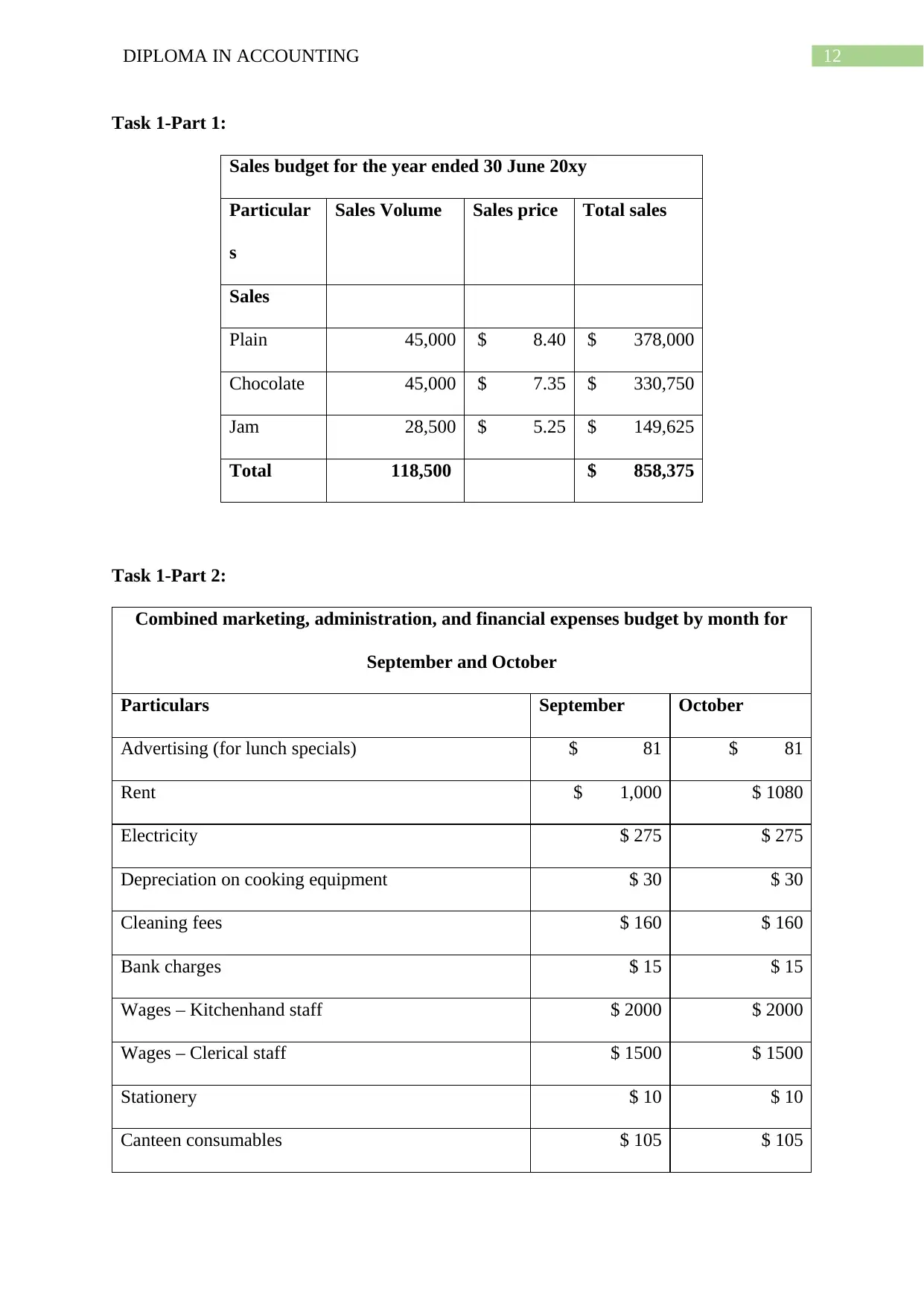
12DIPLOMA IN ACCOUNTING
Task 1-Part 1:
Sales budget for the year ended 30 June 20xy
Particular
s
Sales Volume Sales price Total sales
Sales
Plain 45,000 $ 8.40 $ 378,000
Chocolate 45,000 $ 7.35 $ 330,750
Jam 28,500 $ 5.25 $ 149,625
Total 118,500 $ 858,375
Task 1-Part 2:
Combined marketing, administration, and financial expenses budget by month for
September and October
Particulars September October
Advertising (for lunch specials) $ 81 $ 81
Rent $ 1,000 $ 1080
Electricity $ 275 $ 275
Depreciation on cooking equipment $ 30 $ 30
Cleaning fees $ 160 $ 160
Bank charges $ 15 $ 15
Wages – Kitchenhand staff $ 2000 $ 2000
Wages – Clerical staff $ 1500 $ 1500
Stationery $ 10 $ 10
Canteen consumables $ 105 $ 105
Task 1-Part 1:
Sales budget for the year ended 30 June 20xy
Particular
s
Sales Volume Sales price Total sales
Sales
Plain 45,000 $ 8.40 $ 378,000
Chocolate 45,000 $ 7.35 $ 330,750
Jam 28,500 $ 5.25 $ 149,625
Total 118,500 $ 858,375
Task 1-Part 2:
Combined marketing, administration, and financial expenses budget by month for
September and October
Particulars September October
Advertising (for lunch specials) $ 81 $ 81
Rent $ 1,000 $ 1080
Electricity $ 275 $ 275
Depreciation on cooking equipment $ 30 $ 30
Cleaning fees $ 160 $ 160
Bank charges $ 15 $ 15
Wages – Kitchenhand staff $ 2000 $ 2000
Wages – Clerical staff $ 1500 $ 1500
Stationery $ 10 $ 10
Canteen consumables $ 105 $ 105
⊘ This is a preview!⊘
Do you want full access?
Subscribe today to unlock all pages.

Trusted by 1+ million students worldwide
1 out of 21
Related Documents
Your All-in-One AI-Powered Toolkit for Academic Success.
+13062052269
info@desklib.com
Available 24*7 on WhatsApp / Email
![[object Object]](/_next/static/media/star-bottom.7253800d.svg)
Unlock your academic potential
Copyright © 2020–2025 A2Z Services. All Rights Reserved. Developed and managed by ZUCOL.





